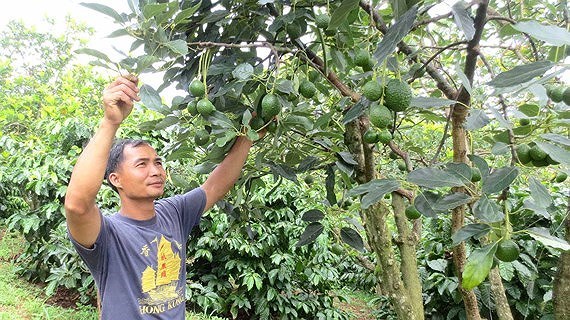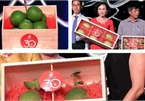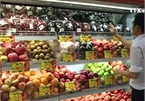 |
Fruit and vegetables have been one of the key export staples which has enjoyed consistent growth in recent years. Despite a number of difficulties, veggie and fruit export turnover aim to gross US$4.2 billion this year.
In July alone, fruit and vegetable exports raked in US$244.30 million, bringing the total seven-month export turnover to US$2.3 billion, up 0.13 per cent compared to the same period last year.
Currently, Vietnam's fruit and vegetable products have established a strong presence in nearly 55 countries, whilst a number of major markets have seen strong growth, including China, Japan, the United States, Russia, Taiwan (China), the Republic of Korea, the Netherlands, Singapore, and Thailand.
Fruit and vegetable exports see plenty of room for growth
According to statistics released by the General Department of Vietnam Customs, China remains the leading consumption market for the country’s fruit and vegetables during the first half of this year, making up 71.5 per cent of the country’s total export turnover and earning a revenue of US$1.46 billion. This figure shows a slight fall of 1 per cent against last year's corresponding period.
The EU represents the second largest consumer market for the Southeast Asia country’s fruit and vegetables, accounting for 3.6 per cent, a sharp increase of 33.9 per cent, followed by the ASEAN market at US$70.16 million, down 12.2 per cent, the US market at US$70.15 million, up 13.3 per cent and the Republic of Korea at US$65.14 million, an increase of 12.2 per cent.
During the reviewed period, veggie and fruit exports to foreign markets saw a rise in export turnover in comparison to last year’s corresponding period, mainly in markets such as Indonesia (up 339 per cent), Italy (up 208 per cent), Laos (up 161.8 per cent), and Hong Kong (up 133.3 per cent).
According to economists, although the EU is a potential market for the nation’s fruit and vegetable exports, there needs to be a number of certificates necessary in order to gain entry into this demanding market. While each EU market asks for different certificates, all of the markets require food safety certificates.
The Import-Export department under the Ministry of Industry and Trade (MOIT), said that the country’s average output of vegetables has reached 14.6 million tons per year, while fruit output stands at 7 million tons per year.
The average growth rate of the fruit and vegetable sector during the 2011-2018 period hit 32.2 per cent, while last year’s exports enjoyed a surge of 8.8 per cent to US$3.8 billion over the previous year’s figure.
To fully tap into the potential of each market, the MOIT, in collaboration with the Ministry of Agriculture and Rural Development, have been actively conducting negotiations in order to help products such as longan, rambutan, and lychee make inroads into the Republic of Korea, Japan, New Zealand, Brazil, and Argentina. This is in addition to star apples to the US market, and pomelo and custard apple to Chinese market.
China tightens export requirements through official channels
At present, China remains the leading consumption market for Vietnam’s fruits and vegetables. However, the Asian giant looks set to apply stricter requirements on fruit imports in the future, according to the Plant Protection Department.
Vietnam currently exports nine types of fresh fruits to China including dragon fruit, watermelon, lychee, longan, banana, mangoe, jackfruit, rambutan, and mangosteen.
On April 26, the two countries signed a protocol to boost the export of mangosteen and dairy products from Vietnam to China.
In May 2018, China revealed that it will be tightening regulations for Vietnamese fruit exports through both unofficial and official channels.
Accordingly, in order to trace the origin of products, China has requested that local fruits be given codes indicating both growing areas and their packaging facilities. These are the two requirements for imported fruits through official channels.
With nine types of fresh fruits being exported to China through official channels, Vietnam has 1,300 codes for growing areas and more than 1,435 codes for packaging facilities.
Under the current regulations, China accepts the codes for growing areas and packaging facilities granted by Vietnam. It does not inspect the process by which the codes are granted.
In the future, China is to apply stricter requirements and standards to stand alongside specific conditions and inspections. If the Vietnamese side fails to comply with this standard, China will say no to all certificates and codes granted by Vietnam.
The Plant Protection Department has recently warned that all provinces and packaging facilities must strictly follow the standards set forth by China. VOV

Businesses spend big money on fruit processing technology
Preservation and processing technologies are the key to increasing the value of farm produce exports, experts say.

List of luxury fruits available in Vietnam
Here are some of the luxury fruits which can be purchased in Vietnam, albeit at high prices.

Local fruit strives to win back domestic market
The total value of Vietnamese fruit market is estimated at $20 to $30 billion. However, this thriving market seems to be neglected by agro firms, while there have been more and more imported fruits showing up in Vietnamese people’s fridges.
 Improving product quality and promoting exports through official channels are seen as a stable method of development for Vietnam's fruit and vegetables as China looks set to apply stricter requirements on fruit imports in the future.
Improving product quality and promoting exports through official channels are seen as a stable method of development for Vietnam's fruit and vegetables as China looks set to apply stricter requirements on fruit imports in the future.